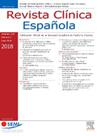Anticuerpos anti-NOR90 y su significación clínica: experiencia multicéntrica en el sur de España
IF 1.7
4区 医学
Q2 MEDICINE, GENERAL & INTERNAL
引用次数: 0
Abstract
Introduction
Anti-NOR90 antibodies were initially described in patients with autoimmune diseases based on staining of a nucleolar region known as the nucleolar organizer region (NOR). This study aims to explore the clinical aspects of anti-NOR90 antibodies in patients with systemic autoimmune diseases.
Methods
Observational study of patients with positive anti-NOR90 antibodies using the EUROLINE Systemic Sclerosis profile (IgG) kit (Euroimmun, Germany). Data on demographics, comorbidities, autoimmune diseases, treatment, and clinical manifestations were collected.
Results
Fifteen patients with positive anti-NOR90 antibodies were included. Majority were female (86.7%), with median age of 54 years. Most common clinical manifestations were Raynaud's phenomenon, dryness, and interstitial lung disease (ILD). Some patients had hematological or solid organ neoplasms. EPID was prevalent, with one case showing rapid progression requiring aggressive treatment.
Discussion and conclusions
This study highlights the association between anti-NOR90 antibodies and systemic autoimmune diseases, particularly SS and ES. EPID was a notable feature, suggesting its consideration in IPAF diagnosis for anti-NOR90 positive patients. Further multicenter studies are needed for better understanding and detection methods optimization.
抗NOR90抗体及其临床意义:西班牙南部的多中心经验
抗nor90抗体最初在自身免疫性疾病患者中被描述为基于核仁组织区(NOR)的染色。本研究旨在探讨抗nor90抗体在全身性自身免疫性疾病患者中的临床意义。方法采用EUROLINE系统性硬化症IgG检测试剂盒(euroimmune,德国)对抗nor90抗体阳性患者进行观察性研究。收集了人口统计学、合并症、自身免疫性疾病、治疗和临床表现的数据。结果共纳入15例抗nor90抗体阳性患者。多数为女性(86.7%),中位年龄54岁。最常见的临床表现为雷诺现象、干燥和间质性肺疾病(ILD)。部分患者有血液学或实体器官肿瘤。EPID很普遍,其中1例进展迅速,需要积极治疗。本研究强调了抗nor90抗体与全身自身免疫性疾病,特别是SS和ES之间的关联。EPID是一个值得注意的特征,提示在诊断抗nor90阳性患者的IPAF时应考虑EPID。需要进一步的多中心研究来更好地理解和优化检测方法。
本文章由计算机程序翻译,如有差异,请以英文原文为准。
求助全文
约1分钟内获得全文
求助全文
来源期刊

Revista clinica espanola
医学-医学:内科
CiteScore
4.40
自引率
6.90%
发文量
73
审稿时长
28 days
期刊介绍:
Revista Clínica Española published its first issue in 1940 and is the body of expression of the Spanish Society of Internal Medicine (SEMI).
The journal fully endorses the goals of updating knowledge and facilitating the acquisition of key developments in internal medicine applied to clinical practice. Revista Clínica Española is subject to a thorough double blind review of the received articles written in Spanish or English. Nine issues are published each year, including mostly originals, reviews and consensus documents.
 求助内容:
求助内容: 应助结果提醒方式:
应助结果提醒方式:


